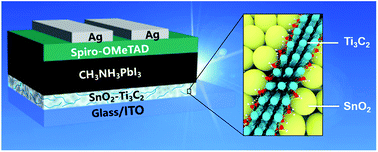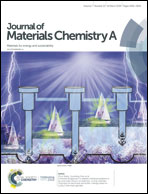SnO2–Ti3C2 MXene electron transport layers for perovskite solar cells†
Abstract
MXenes, a class of two-dimensional (2D) transition metal carbides and nitrides, have a wide range of potential applications due to their unique electronic, optical, plasmonic, and other properties. Herein, we explore the use of the Ti3C2 MXene in organic–inorganic lead halide perovskite solar cells (PSCs). SnO2–Ti3C2 MXene nanocomposites with different contents of Ti3C2 (0, 0.5, 1.0, 2.0, and 2.5 wt‰) were used as electron transport layers (ETLs) in low-temperature processed planar-structured PSCs. Mixing SnO2 with 1.0 wt‰ Ti3C2 effectively increases the power conversion efficiency (PCE) from 17.23% to 18.34%, whereas the device prepared with pristine Ti3C2 as the ETL achieves a PCE of 5.28%. Photoluminescence and electrochemical impedance spectroscopy results reveal that metallic Ti3C2 MXene nanosheets provide superior charge transfer paths, enhancing electron extraction, electron mobility, and decreasing the electron transfer resistance at the ETL/perovskite interface, and thus leading to higher photocurrents. This work proposes a new field of application for MXenes and a promising method to increase the efficiency of solar cells.



 Please wait while we load your content...
Please wait while we load your content...